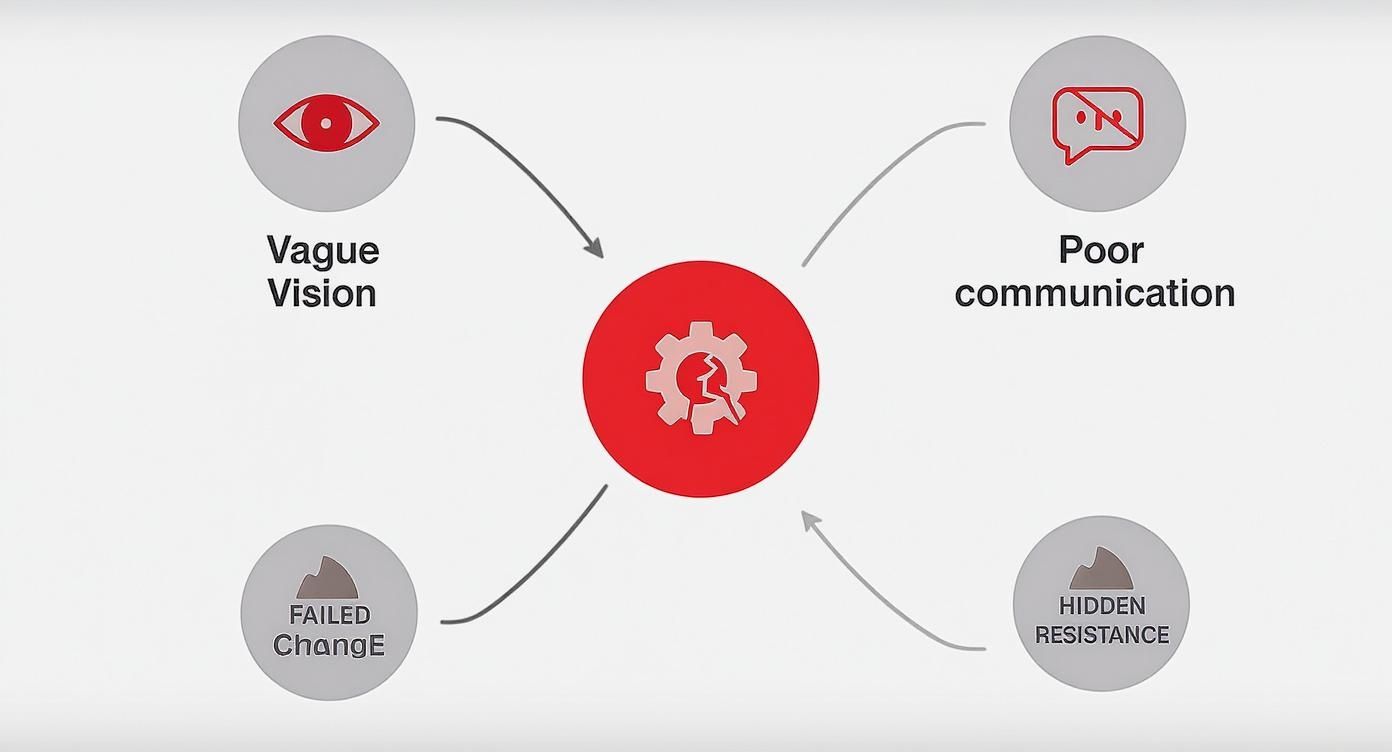Australia
Organisational change management is, at its core, the structured way we guide people, teams, and an entire company from where they are today to where they need to be tomorrow. It’s all about the human side of change, making sure that any new process or technology isn't just switched on, but is actually welcomed and used by the very people who need it to do their jobs.
Understanding the Foundations of Change Management

Picture your company as a large ship. You can’t just turn the rudder and expect everyone on board to instantly adapt to the new direction. Real change management is the entire process of getting the crew ready for the journey.
It’s about making sure everyone knows where the ship is headed and, crucially, why that new destination is better than the old one. It also means giving them the right skills to navigate unfamiliar waters and supporting them through the storms that will inevitably come. Without that focus on your people, the ship might turn, but you’ll be left with a confused, resistant, and unprepared crew.
The Core Purpose of This Process
When you get right down to it, this discipline is built on a simple truth: organisational results are just the sum of individual actions. That fancy new software system only delivers a return on investment when employees actually use it. A merger only truly succeeds when the teams from both sides learn to work together, blending their cultures and processes.
So, the primary goals of change management are to:
- Minimise Resistance: To get ahead of the curve by addressing employee concerns, cutting through the uncertainty, and building genuine buy-in for a smoother transition.
- Maximise Adoption: To ensure that new tools, processes, and mindsets are used consistently and skillfully across the whole organisation.
- Accelerate Realisation of Benefits: To shorten the time it takes to get from the project's launch to seeing the actual, tangible results you were aiming for.
Of course, you can't talk about change without understanding organizational culture. The existing culture—those shared values, beliefs, and unwritten rules—has a massive impact on how easily people will accept something new. If your change initiative clashes with the way things are done around here, you're in for a tough ride.
The ultimate goal is to move from a state of disruption to a new state of stability and improved performance as efficiently as possible, with employee wellbeing at the centre of the strategy.
The Three Phases of Change
While there are plenty of different models out there, almost every structured approach follows a logical path that can be broken down into three key stages. This simple framework helps leaders guide their teams through the messy reality of a transformation, making sure no critical steps get missed.
These phases are:
- Preparing for Change: This is the foundational work. It involves figuring out the true impact of the change, creating a clear strategy, and getting a strong group of leaders to champion the cause.
- Managing the Transition: This is where the action happens. Communication plans are rolled out, people get the training they need, and any resistance is handled with supportive coaching and open conversations.
- Reinforcing the New State: Once the change is technically "live," the work isn't over. This final stage is all about gathering feedback, measuring success, and embedding the new ways of working until they just become the new normal.
Why Most Change Initiatives Fail Without a Plan
Kicking off a major organisational change without a solid plan is a lot like setting sail across an ocean with no map, no compass, and no idea what the weather is doing. The destination might seem clear in a leader’s mind, but the journey is filled with hidden dangers that can easily sink the entire mission. The hard truth is that good intentions just aren't enough to navigate the messy realities of human behaviour and organisational inertia.
This is exactly why a shocking number of transformations never quite make it. In Australia and around the world, the landscape of change is tough; as of early 2025, nearly 70% of major change initiatives fail to actually hit their targets. On top of that, 50% of business leaders admit they're unsure if recent changes were even successful, which points to a huge gap between taking action and getting results. You can find more details in these organisational change management statistics on changing-point.com.
These failures rarely happen because of one big disaster. Instead, they’re usually the slow-burning result of interconnected problems that a proper change management plan would have tackled from day one.
The Iceberg of Ignorance
A great way to understand why change fails is the "iceberg of ignorance" analogy. From the boardroom, leaders often only see the very tip of the iceberg—the obvious, operational issues like clunky software or inefficient processes. They build a change initiative based only on what they can see.
But submerged just below the surface is the massive, unseen part of the iceberg. This is where you find the deep-seated cultural norms, employee fears, unspoken anxieties, and old habits that really drive how people behave. Without a plan to deal with this hidden monster, leaders are essentially steering their ship straight into a collision.
An unplanned change initiative focuses on the symptoms that leaders can see, while a strategic change management plan addresses the root causes hidden within the organisation's culture and its people.
Common Pitfalls of Unplanned Change
When organisations just try to "wing it," they almost always fall into the same predictable traps. These aren't just minor mistakes; they are fundamental flaws that destroy trust, create chaos, and ultimately condemn the project to failure.
Here are the key failure points:
- A Vague or Uninspiring Vision: Leadership doesn’t create a compelling "why" behind the change. Employees are left thinking, "What's in this for me?" or "Why are we going through all this pain?"
- A Communication Vacuum: When clear, consistent, and honest communication is missing, rumours and fear rush in to fill the void. This toxic environment builds resistance before the change has even started.
- Underestimating Employee Resistance: Treating resistance as a discipline issue instead of a natural human reaction is a massive mistake. Unplanned changes often steamroll right over the genuine concerns employees have about their jobs, workload, and skills.
- Lack of Visible Sponsorship: When senior leaders announce a change and then vanish, it sends a crystal-clear message: this isn't a real priority. Active and visible sponsorship from the top is non-negotiable.
Many of these issues are closely related to the common digital transformation challenges businesses run into, which proves that whether a change is about technology or culture, the human element is always the most critical piece of the puzzle. Neglecting that human element can also open up vulnerabilities far beyond a failed project. For a closer look at how to protect your organisation's assets during times of flux, check out our guide on cybersecurity for small businesses.
In the end, the costs of a failed initiative are huge. They go way beyond the wasted money and include shattered employee morale, a deep loss of trust in leadership, and a damaged company reputation that makes any future changes even harder to pull off.
Proven Models for Navigating Change
Successfully guiding a team through change takes more than just a good idea and strong leadership; it demands a reliable map. Without a structured framework, even the best-intentioned plans can get lost in a fog of confusion and resistance. That’s where proven organisational change management models come in, providing the clear, actionable steps needed to turn a vision into reality.
These aren't rigid, academic theories. Think of them as practical toolkits, each designed to tackle change from a different but equally important angle. By understanding how they work, you can pick the right approach for your specific challenge, whether you're rolling out new software or merging two distinct company cultures.
The infographic below shows the common pitfalls that a structured change model helps you avoid, like a vague vision, poor communication, and hidden resistance.

This visual drives home a critical point: failing to address these core human elements can sink an initiative before it even starts. It reinforces the need for a deliberate, people-focused strategy.
Kotter’s 8-Step Process for Leading Change
Developed by Harvard Business School professor John Kotter, this model is a top-down, strategic roadmap for large-scale organisational transformations. It’s built on the idea that for big change to stick, you first have to build powerful momentum and get key leaders on board. It’s a brilliant framework for driving change from the top down.
Kotter's process unfolds in eight logical steps:
- Create a Sense of Urgency: This is about making the need for change feel real and immediate. Leaders must go beyond abstract data and paint a compelling picture of the risks of standing still versus the opportunities of moving forward.
- Build a Guiding Coalition: No single person can drive major change alone. This step is about assembling a powerful group of influential leaders from across the organisation who are fully committed to the vision.
- Form a Strategic Vision and Initiatives: The coalition’s job is to create a clear, simple, and inspiring vision of the future. This vision acts as the guiding star for the entire effort.
- Enlist a Volunteer Army: With the vision in place, the next task is to communicate it broadly and get a critical mass of people excited to make it happen.
- Enable Action by Removing Barriers: Hunt down and remove obstacles that could slow things down, such as outdated processes, bureaucratic red tape, or organisational silos.
- Generate Short-Term Wins: Big transformations take time. Celebrating small, visible victories along the way keeps morale high and proves to sceptics that the change is actually working.
- Sustain Acceleration: After the first few wins, it's tempting to declare victory. Kotter warns against this, urging leaders to use the credibility from early successes to tackle even bigger challenges.
- Institute Change: Finally, anchor the new approaches deep within the organisation's culture. This ensures the changes stick for the long term and become "the way we do things here."
The Prosci ADKAR Model for Individual Change
While Kotter’s model looks at the organisation as a whole, the Prosci ADKAR Model takes a different tack. It’s a bottom-up framework focused on the individual’s journey through change. The core idea is simple: organisational change only happens when individuals change their behaviours, one person at a time.
ADKAR is an acronym for the five outcomes an individual must achieve for any change to be successful:
- Awareness: Understanding the why behind the change.
- Desire: Making the personal decision to support and participate.
- Knowledge: Knowing how to change and what the new skills are.
- Ability: Demonstrating the capability to use the new skills and behaviours.
- Reinforcement: Having systems in place that make the change stick.
This model is incredibly practical for managers and team leaders. It gives them a clear lens to figure out why a change might be stalling. For instance, if an employee isn't using a new system, is it because they lack the Knowledge (need more training) or the Desire (don't see the personal benefit)? This targeted approach helps resolve resistance right at its source.
The ADKAR Model transforms change management from a top-down mandate into a process of enabling individual success, recognising that lasting transformation is the sum of many personal transitions.
Comparing Kotter's 8-Step Model vs. The ADKAR Model
So, which model is better? It’s not about which one is superior; it’s about understanding that they serve different, yet complementary, purposes. Kotter provides the high-level strategic roadmap for the organisation, while ADKAR offers the granular, person-by-person implementation plan. In fact, many organisations use them together to great effect.
Here’s a quick comparison to help you see where each model shines.
| Aspect | Kotter's 8-Step Process | Prosci ADKAR Model |
|---|---|---|
| Primary Focus | Organisational-level, top-down strategy. | Individual-level, bottom-up transitions. |
| Best Use Case | Large-scale, complex transformations requiring strong leadership buy-in. | Ensuring individual adoption and proficiency with new tools or processes. |
| Key Strength | Creates urgency and powerful momentum for change across the entire business. | Pinpoints and addresses the specific reasons for individual resistance. |
Ultimately, using Kotter helps create the environment for change, while ADKAR ensures the people within that environment can successfully make the transition.
For instance, a company adopting new technology might use Kotter’s steps to create urgency and build a guiding coalition at the leadership level. Then, as they roll out the software, they can use the ADKAR model to ensure every single employee gains the Awareness, Desire, Knowledge, Ability, and Reinforcement needed to adopt it. A critical part of this is securing the new systems, which is why a foundational understanding of concepts like what is two-factor authentication becomes part of the Knowledge phase, ensuring security protocols are followed from day one.
The best choice depends entirely on your specific context and goals. By having both these powerful models in your change management toolkit, you are far better equipped to navigate the complexities of any transformation.
The Human Element of Leading Change

While models and roadmaps give you a structure for managing organisational change, they’re just the blueprints. The real work of building a new future is done by your people. This makes the human element the most critical—and often most underestimated—part of any transformation.
Too often, leaders see employee resistance as defiance or a roadblock to be smashed through. This perspective is a fundamental mistake. Resistance isn't a sign of insubordination; it’s a natural human response to uncertainty, a perceived loss of control, and a disruption to everything familiar.
Think of it like this: your team has been driving the same comfortable road to work for years. Suddenly, you announce the road is closing permanently and they have to find a new, unfamiliar route. Their first reaction won’t be excitement. It’ll be anxiety, frustration, and a flood of questions. That’s resistance in its purest form.
Understanding the Psychology of Resistance
The moment a change is announced, employees immediately start processing what it means for them, personally. Their minds race with worries about job security, whether they can learn new skills, and what their place will be in the new order of things. This isn't just a business process; it’s an emotional journey.
Effective change management shifts the focus from managing a project to leading people. It’s about empathy, not just efficiency. This means creating an environment where people feel safe enough to voice their concerns without being judged.
The goal isn’t to eliminate resistance—that’s impossible. The goal is to understand where it’s coming from and address the underlying fears fuelling it. This is how you turn potential critics into engaged participants.
To do this, leaders must prioritise creating what’s known as psychological safety. This is the shared belief that it's safe to take interpersonal risks within the team. When people feel safe, they’re more willing to ask questions, admit they’ve made a mistake, or offer new ideas—all crucial behaviours for navigating a successful change.
Fostering Transparency and Building Trust
Trust is the currency of change. Without it, even the most brilliant strategy is doomed to fail. The fastest way to destroy that trust is to create a communication vacuum, where rumours and fear thrive. That’s why transparent, consistent, and empathetic communication is non-negotiable.
Recent Australian workplace surveys really bring this challenge to light, showing that engagement and psychological well-being are major hurdles during change. Data from late 2024 and early 2025 reveals that only about 70% of Australian employees are actively engaged, placing the country in the bottom half of global regions. This is often tied directly to the stress and uncertainty caused by poorly managed change. You can find out more by exploring Gallagher’s 2025 workforce trends report.
Building trust during a period of upheaval requires a deliberate communication strategy:
- Communicate the 'Why' Relentlessly: Don't just announce what's changing. Explain the reasons behind it, the problems it solves, and the better future it creates.
- Be Honest About the Challenges: Acknowledge that the transition will have its bumps. Being upfront about potential difficulties makes you far more credible when you talk about the benefits.
- Create Two-Way Channels: Communication should never be a one-way broadcast. Set up forums for questions, listen actively to feedback, and show that you’re taking concerns seriously.
A clear communication plan is fundamental. For guidance on structuring formal communications like announcements or policy updates, understanding the proper business letter format can help ensure your messages are professional and clear.
Turning Employees into Active Participants
Ultimately, the most effective way to manage the human side of change is to stop doing it to your employees and start doing it with them. When people are actively involved in the process, they gain a sense of ownership and control, which powerfully counteracts feelings of helplessness.
Consider these strategies to get people involved:
- Form a Change Champion Network: Identify influential and respected employees from different departments. Give them the inside scoop and empower them to be ambassadors for the change among their peers.
- Involve Teams in Solution Design: Wherever you can, ask teams to help design the new workflows or processes that will directly affect them. They are the experts in their own jobs and their insights are invaluable.
- Use Pilot Programs: Before a full-scale rollout, test the change with a smaller group. This allows you to gather feedback, iron out the kinks, and create success stories that build momentum.
By addressing these human factors with empathy and genuine leadership, a change initiative moves beyond simple implementation. It becomes a transformation that isn't just accepted, but truly embraced by the very people who make it a reality.
A Practical Roadmap to Implementing Change
All the theory in the world won't help if you don't know how to apply it. Knowing the 'why' of change management is one thing, but a practical roadmap gives you the 'how'. We've boiled down the proven concepts into a clear, five-phase sequence you can adapt for your own initiative.
Think of these steps as a guide to turn those big, abstract goals into real, tangible actions. It’s not a rigid formula you have to follow to the letter, but a flexible framework designed to bring some much-needed structure to what can often feel like a chaotic process. Let’s walk through it, one step at a time.
Phase 1: Assess the Change Impact
Before you can plan the journey, you have to understand the terrain. The first phase is all about getting a handle on what the change actually means for your organisation and, most importantly, for its people. This goes way beyond a surface-level project brief; you need to dive deep into how roles, daily processes, and even the company culture will be affected.
A stakeholder analysis is your crucial first step here. Identify every single group touched by the change, from the C-suite down to the frontline staff. For each group, map out exactly how their day-to-day work, tools, and responsibilities are going to be different. This detailed groundwork is the foundation of your entire change strategy.
A common mistake is assuming a one-size-fits-all approach. By assessing the unique impact on different teams, you can tailor your communication and support, addressing specific concerns before they grow into widespread resistance.
Phase 2: Develop a Strategy and Team
Once you have a clear picture of the impact, you can build a solid strategy and assemble the right team to pull it off. This is where you define what success looks like, set clear objectives, and establish your key performance indicators (KPIs). Your strategy should map out the scope of the change, the key milestones, and the resources you'll need.
A huge part of this phase is forming a guiding coalition—your change management team. This group absolutely needs to include:
- An Executive Sponsor: A senior leader who can champion the change and clear high-level roadblocks.
- Project Managers: The people who will handle the technical and logistical side of the implementation.
- Change Champions: Respected employees from different departments who can act as advocates and provide that vital peer-to-peer support.
This mix of people ensures that both the technical and the human sides of the change are managed together, creating a united front that drives the initiative forward. Data from these teams is vital, and you might find our guide on how to use Excel for dummies helpful for organising and tracking feedback and metrics.
Phase 3: Create a Communication Plan
Communication is the lifeblood of any change initiative. A well-thought-out plan ensures the right messages get to the right people at the right time, through the right channels. You need to be proactive, transparent, and consistent to build awareness and, crucially, a genuine desire for the change.
Your plan should detail:
- Key Messages: The core "why" behind the change, but tweaked for different audiences. What resonates with IT won't be the same for the sales team.
- Communication Channels: Use a mix of town halls, emails, team meetings, and intranet updates to keep everyone in the loop.
- Timeline: A schedule for when key information will be released, making sure it lines up with your project milestones.
And don't forget to build in opportunities for two-way feedback. This isn't just about broadcasting messages; it's about listening. It lets you tackle concerns head-on, squash rumours, and make your employees feel heard.
Phase 4: Execute and Manage the Transition
This is where the rubber meets the road. All your plans turn into action as you roll out the new processes, systems, or structures. But just as important is actively managing the human side of the transition. This is when training, coaching, and support become absolutely critical.
Your change champions are invaluable during this phase. They’re on the ground, providing support, answering questions, and feeding back what they’re hearing from their teams. It's also vital to anticipate and manage resistance. Don't dismiss concerns—listen to them and address the root causes.
The Australian job market really brings this to life, with so many industries moving towards automation and reskilling. Businesses often struggle because they lack the data to decide whether to reskill, redeploy, or restructure their workforce during these shifts. This is exactly where structured change management is needed. You can discover more insights on the Australian market's evolution and its impact on hiring on whitecloudrecruitment.com.au.
Phase 5: Measure and Reinforce Success
The work isn’t over just because the change is officially "live." The final phase is all about making sure the new ways of working stick until they become the new normal. This means measuring your success, gathering feedback, and reinforcing the behaviours you want to see.
Track both hard and soft metrics. Quantitative data might be adoption rates for new software or efficiency gains. Qualitative data could come from employee satisfaction surveys. Make sure to celebrate the short-term wins publicly to build momentum and show everyone the positive impact of the change. By consistently reinforcing the new behaviours, you ensure the transformation lasts for the long haul.
Got Questions About Change Management? We’ve Got Answers
Even with the best models and a solid roadmap, you're bound to hit some practical hurdles when you're in the trenches leading change. This is where theory meets reality. Let's tackle the most common questions leaders ask as they start putting their plans into action.
What Is the Single Biggest Mistake to Avoid?
Without a doubt, it’s poor communication. And I don’t just mean forgetting to send a weekly email update. The real mistake is failing to build a clear, compelling story around why the change is happening. When leadership leaves an information vacuum, people will always fill it with the worst-case scenario—rumours, fear, and resistance.
A great change initiative is built on a proactive, consistent, and two-way communication plan. You need to be honest about the vision, really listen to people's concerns, and make sure that message is being shared clearly at every level of the business.
The point of communication during change isn't just to inform. It's to build trust. When people feel heard and respected, they're far more likely to get on board.
How Do You Actually Measure the Success of a Change Initiative?
Measuring success is about more than just checking boxes to say a project is "done." You need a balanced view, using both hard numbers and human feedback to see if the change has truly taken hold.
Here’s a simple way to break it down:
- Quantitative Metrics: These are your hard numbers. Think project milestones, staying on budget, adoption rates for a new system, and improvements in key performance indicators (KPIs) like efficiency gains or fewer errors.
- Qualitative Metrics: This is all about the people. Use employee surveys, focus groups, and one-on-one chats to get a feel for morale, engagement, and whether new behaviours are actually becoming part of the daily culture.
Putting these two together tells you not just if the project was delivered, but if it was actually embraced.
How Do You Manage Resistance from Long-Term Employees?
When you’re dealing with resistance from your most tenured employees, your first instinct should be empathy, not authority. These are often the people with the deepest emotional investment in the way things have always been done. Their hesitation rarely comes from a place of defiance; it’s usually rooted in a real fear of losing their expertise, their status, or just their sense of stability.
The first step is to listen. Try to understand the root cause of their resistance and acknowledge the value of their experience. One of the most powerful things you can do is involve them directly in the process.
Turn them into part of the solution. Ask for their input on how to roll things out, or even make them a 'change champion' for their team. When you do that, their deep institutional knowledge transforms from a barrier into one of your greatest assets.
What Is the Role of Middle Managers in All This?
Middle managers are the absolute linchpins of any organisational change. They’re the ones who have to translate the big-picture vision from the executive team into day-to-day reality for their people. Forgetting to equip and empower this group is one of the fastest ways to fail.
Their role is really twofold:
- Translate Downwards: They coach their employees, reinforce the new ways of working, and make the change feel relevant to their team’s specific job.
- Feed Information Upwards: They are your eyes and ears on the ground. They need to be able to relay feedback, concerns, and roadblocks from their teams back up to senior leadership.
Without their active support, even the most brilliant strategy will fall flat. Their effectiveness also depends on secure communication, and our guide on how to prevent data breaches offers some useful insights for keeping information safe during these crucial periods.
At Digital Hub Key, we provide the genuine software licenses your organisation needs to power its transformation. Get instant access to essential tools like Windows, Microsoft Office, and top-tier security software to equip your team for success. https://digitalhubkey.com






[…] To really solidify your vision, consider using a great e-commerce business plan template. This process prepares you for the inevitable pivots and changes that come with building a business. In fact, learning to manage those shifts is a skill in itself, which you can read more about in our guide on https://blogs.digitalhubkey.com/organizational-change-management. […]